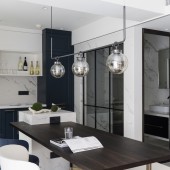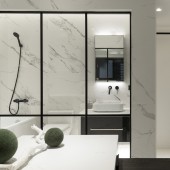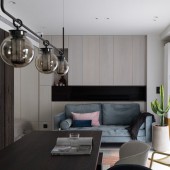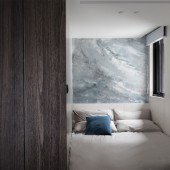
| THE AWARD |
| CATEGORIES |
| REGISTRATION |
| SUBMIT YOUR WORK |
| ENTRY INSTRUCTIONS |
| TERMS & CONDITIONS |
| PUBLICATIONS |
| DATES & FEES |
| METHODOLOGY |
| CONTACT |
| WINNERS |
| PRESS ROOM |
| GET INVOLVED |
| DESIGN PRIZE |
| DESIGN STORE |
| THE AWARD | JURY | CATEGORIES | REGISTRATION | PRESS | WINNERS | PUBLICATIONS | ENTRY INSTRUCTIONS |
Microflat X Space Utility by HSIN-YU, HSIEH |
Home > Winners > Design #84231 >Interview |
 |
|
FS: What is the main principle, idea and inspiration behind your design?
HH: Inspired by the game Tetris and its tile-matching/overlapping characteristics, interior spaces are designed to be fully integrated with one area to another, maximizing spacing utility and redefining the meaning of “big” and “small”
FS: What has been your main focus in designing this work? Especially what did you want to achieve?
HH: Space utility can be maximized to enjoy aspects of a luxurious apartment.
FS: What are your future plans for this award winning design?
HH: Better visibility and more design
FS: How long did it take you to design this particular concept?
HH: one year
FS: Why did you design this particular concept? Was this design commissioned or did you decide to pursuit an inspiration?
HH: This consequentially gave the genesis of the interior space sharing design, in which spaces are interconnected with one another and different usage applications can be flexibly accommodated.
FS: Is your design being produced or used by another company, or do you plan to sell or lease the production rights or do you intent to produce your work yourself?
HH: self-produce
FS: What made you design this particular type of work?
HH: Create big space
FS: Where there any other designs and/or designers that helped the influence the design of your work?
HH: Design becomes more yuan
FS: Who is the target customer for his design?
HH: Space user
FS: What sets this design apart from other similar or resembling concepts?
HH: Belong to using a unique space
FS: How did you come up with the name for this design? What does it mean?
HH: Micro is not defined
FS: Which design tools did you use when you were working on this project?
HH: CAD
FS: What is the most unique aspect of your design?
HH: There is very little such thinking in Taiwan.
FS: Who did you collaborate with for this design? Did you work with people with technical / specialized skills?
HH: Professional and technical personnel to participate together
FS: What is the role of technology in this particular design?
HH: Create big space
FS: Is your design influenced by data or analytical research in any way? What kind of research did you conduct for making this design?
HH: according to the type of occasion. This redefines the traditional perspective of “space usage”, underscoring the flexibility of the interior.
FS: What are some of the challenges you faced during the design/realization of your concept?
HH: Because of the known limitations of micro-spaces, projecting and executing the blue print onto the available interior spaces proportionally with precision
FS: How did you decide to submit your design to an international design competition?
HH: Internet
FS: What did you learn or how did you improve yourself during the designing of this work?
HH: Expertise and technology and language
FS: Any other things you would like to cover that have not been covered in these questions?
HH: NO
FS: Thank you for providing us with this opportunity to interview you.
A' Design Award and Competitions grants rights to press members and bloggers to use parts of this interview. This interview is provided as it is; DesignPRWire and A' Design Award and Competitions cannot be held responsible for the answers given by participating designers.
| SOCIAL |
| + Add to Likes / Favorites | Send to My Email | Comment | View Press-Release |





